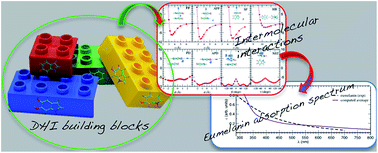Intermolecular interactions in eumelanins: a computational bottom-up approach. I. small building blocks†
Abstract
The non-covalent interactions between pairs of the smallest eumelanins building blocks, 5,6-dihydroxy-indole (DHI) and its redox derivatives, are subjected to a systematic theoretical investigation, elucidating their nature and commenting on some of their possible effects on the layered structure of eumelanin. An accurate yet feasible protocol, based on second order perturbation theory, was set up and validated herein, and thereafter used to sample the intermolecular potential energy surfaces of several DHI related dimers. From the analysis of the resulting local minima, the crucial role of stacking interactions is assessed, evidencing strong effects on the geometrical arrangement of the dimer. Furthermore, the absorption spectra of the considered dimers in their most stable arrangements are computed and discussed in relation to the well known eumelanin broadband features. The present findings may help in elucidating several eumelanin features, supporting the recently proposed geometrical order/disorder model (Chen et al., Nat. Commun. 2014, 5, 3859).


 Please wait while we load your content...
Please wait while we load your content...